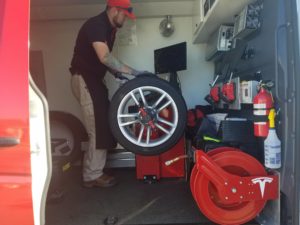Premium Mobile Tire Replacement Las Vegas - High Quality Ensured
Premium Mobile Tire Replacement Las Vegas - High Quality Ensured
Blog Article
Tire Service: Proven Methods for Optimum Tire Upkeep and Treatment
From guaranteeing proper tire pressure to regular rotation and placement, there are tested techniques that can dramatically prolong the lifespan of your tires and boost total driving experience. Allow's delve right into the world of tire service and find the tricks to maintaining your tires in superior form for the lengthy haul - Mobile Tire Replacement Las Vegas.
Importance of Tire Stress
Ample tire pressure promotes better gas performance, as under-inflated tires can lead to increased rolling resistance, triggering the engine to function harder and take in even more fuel. Right tire stress guarantees even step wear, improving tire long life and conserving cash in the lengthy run by delaying the demand for early substitutes. Consistently changing and inspecting tire pressure, particularly previously long journeys, is an easy yet efficient method to boost car performance, prolong tire lifespan, and focus on safety and security on the road.
Tire Rotation Guidelines
When thinking about tire turning guidelines, it is vital to comprehend the importance of this upkeep task in making best use of tire life-span and keeping ideal automobile efficiency. Tire turning entails altering the setting of each tire on a car to guarantee even step wear. Front tires often tend to put on a lot more swiftly than rear tires due to guiding pressures, making regular turning critical for well balanced wear patterns. The advised turning pattern differs relying on whether an automobile is front-wheel, rear-wheel, all-wheel, or 4x4. Normally, tires ought to be rotated every 5,000 to 7,500 miles, or as advised in the lorry handbook. Overlooking tire rotation can cause uneven wear, influencing handling, traction, and potentially compromising automobile safety. By sticking to appropriate turning standards, chauffeurs can expand the life of their tires, enhance fuel effectiveness, and enhance general driving experience. Regular turning is a straightforward yet reliable maintenance practice that contributes considerably to tire longevity and vehicle efficiency.

Benefits of Wheel Placement
Making sure proper wheel placement after tire turning is crucial for maintaining balanced wear patterns and optimizing lorry efficiency. Wheel positioning refers to the adjustment of the angles of the wheels to the manufacturer's requirements. Among the key advantages of wheel alignment is enhanced taking care of and steering action. When the wheels are properly straightened, it decreases guiding effort, ensuring a smoother and much more regulated driving experience. In addition, right wheel positioning assists to expand the life-span of your tires. Misaligned wheels can cause uneven tire wear, causing premature tire substitute and increased upkeep prices.

Tire Tread Deepness Check
Doing a normal examination of tire walk depth is crucial for maintaining risk-free driving problems and lengthening the lifespan of your tires. The step on your tires plays a critical function in offering grip, specifically in this page slippery or damp conditions. To check your tire tread deepness, you can utilize a tread depth gauge or the penny test. The suggested walk depth is at the very least 2/32 of an inch. It is time to replace your tires to ensure optimum performance and security on the road if the walk deepness is listed below this threshold. Unequal tread wear can indicate issues with tire positioning, stress, or suspension, highlighting the relevance of regular step deepness checks. Neglecting to keep track of and keep pop over to this site correct walk deepness can result in reduced grip, longer stopping ranges, and an increased threat of hydroplaning. By including tire tread depth look into your regular upkeep timetable, you can drive with confidence knowing that your tires remain in leading condition.
Seasonal Tire Assessment
Seasonal tire assessment is a basic facet of tire upkeep that makes sure tires are prepared to face the difficulties positioned by different climate problems. In preparation for winter, it is vital to inspect the tire stress consistently as chilly temperature levels can cause tire stress to drop. By conducting regular seasonal tire assessments, drivers can extend tire life expectancy, enhance gas performance, and most notably, make sure a protected driving experience in differing weather condition conditions.
Verdict
To conclude, preserving correct tire pressure, rotating tires frequently, lining up wheels correctly, keeping an eye on tread depth, and carrying out seasonal assessments are vital practices for optimum tire care. By following these proven techniques, drivers can ensure their tires last much longer, perform much better, and add to total vehicle safety and security. It is essential to prioritize tire upkeep to stop crashes, boost fuel performance, and lengthen the lifespan of tires.
Appropriate tire pressure advertises far better gas efficiency, as under-inflated tires can lead to enhanced rolling resistance, creating the engine to function harder and consume more fuel.When taking into consideration tire turning standards, it is essential to understand the significance of this upkeep job in optimizing tire life-span and keeping optimum vehicle performance. Seasonal tire inspection is a fundamental aspect of tire upkeep that guarantees tires are ready to face the challenges positioned by different weather problems. By performing regular seasonal tire examinations, vehicle drivers can lengthen tire life expectancy, improve fuel efficiency, and navigate to this site most importantly, ensure a safe and secure driving experience in differing weather condition conditions.
In conclusion, keeping proper tire stress, turning tires routinely, aligning wheels correctly, monitoring step depth, and conducting seasonal examinations are crucial methods for optimal tire treatment.
Report this page